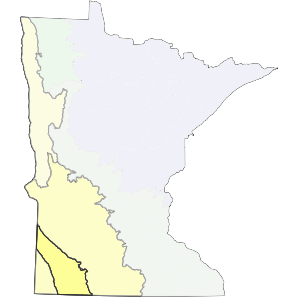The southwestern boundary of this subsection occurs in an area of transition from shallow deposits of wind blown silt (loess) over glacial till to deeper deposits of loess. The northeastern boundary is marked by a steep escarpment which becomes less pronounced to the south.This subsection is part of a high glacial landform occupying Southwestern Minnesota, Southeastern South Dakota, and Northwestern Iowa. It is topped by Buffalo Ridge (1995 feet above sea level) in northern Pipestone County. The high elevation is caused by thick deposits of pre-Wisconsin age glacial till (up to 800 feet thick). There are two distinct parts to the subsection, the middle Coteau, and the outer Coteau.
Landform
There are two distinct landforms in this subsection. The middle Coteau is a landscape of rolling moraine ridges of late-Wisconsin drift mantled with loess 1 to 3 feet thick. The outer Coteau, a series of terminal and end moraines separated by ground moraines, ranges from gently undulating to steeply rolling and hilly. A steep escarpment marks the northeast edge of the subsection. The escarpment is cut by several streams, which occupy narrow, straight ravines (Albert 1993).This escarpment fades to the southeast and becomes indistinct on the Iowa border.


